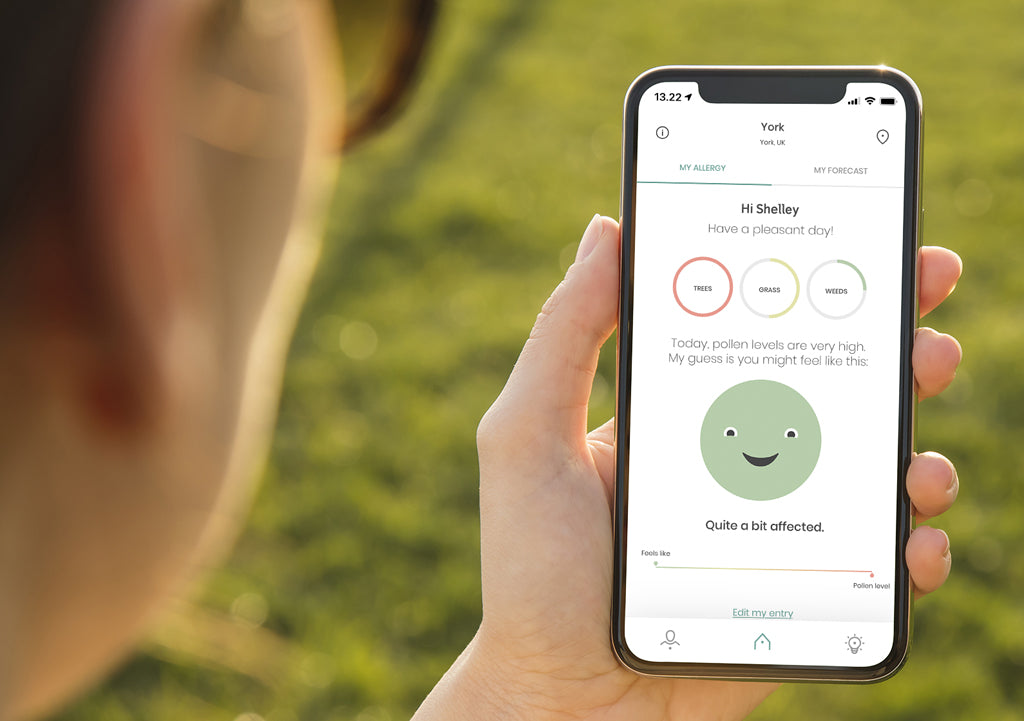What are seasonal allergies?
Seasonal allergies are the ones that mostly happen outdoors and give you hay fever or symptoms like it. They affect you for a few weeks, then go. But you know they’ll be back the same time next year. You can mark it in your diary. Pollen is the main trigger and mould allergy can also be seasonal.
Here we explore which seasonal allergies happen when and why, and how they might make you feel. Read about options for seasonal allergies treatment too.
Seasonal allergies: Something in the air
Seasonal allergens tend to be airborne. You breathe them in and get seasonal allergic rhinitis. That’s the official name for hay fever symptoms.
Plants release thousands of tiny pollen grains. These travel on the wind to fertilise other plants of the same species, sometimes hundreds of miles away. Mould spores can be even smaller than pollen and are just as easy to inhale without realising.
What’s going on inside when you get seasonal allergies?
Your overprotective immune system sees substances like pollen or mould as a threat even though they’re harmless. It prepares its defences by producing IgE (immunoglobulin) antibodies. Now you’re sensitised, ready for the next time you meet your trigger.
Not everyone goes on to develop seasonal allergies. But many do. In which case the antibodies react by mobilising different cells in your body to do different things to get rid of the allergen. Some release histamine which is what causes many of your symptoms.
When do seasonal allergies strike?
Which times of year different seasonal allergies peak depends on where you live. Spring can be full of joy, unless you’re allergic to tree pollen. Summer has the thrill of long vacations…and runny noses if grass pollen or an outdoor mould is your trigger. Autumn is when weeds get busy. Mould spores also love the piles of fallen leaves.
The quietest time for seasonal allergic rhinitis is usually the winter. (Insect allergy has a seasonal bias too; stinging and biting insects are less active in chillier months.) The exception is if you live in a warmer climate where the temperature doesn’t change that much. In which case outdoor mould and grass pollen could be causing seasonal allergies almost all year round.
Some triggers of seasonal allergies
Here are some common plants behind seasonal allergy symptoms:
- Tree pollen: alder, ash, birch, hazel, olive, cypress, oak
- Grass pollen: common meadow grass, meadow foxtail, sweet vernal grass, soft brome, wild oat, Timothy grass, ryegrass, Bermuda grass
- Weed pollen: nettle, mugwort
- Mould spores: Alternaria alternata, Cladosporum herbarium
Pine is often blamed for Christmas tree allergy. But mould on the leaves is the likelier trigger of your festive sneezes. Give the tree a shake before you start draping tinsel and lights.
You’ll notice the list doesn’t include showy bouquet or garden flowers like roses. That’s because they don’t tend to cause allergies. Their pollen is too big and heavy to travel on the wind. The waxy grains are designed to stick to bees and other insects which carry it from plant to plant. The same goes for flowering fruit trees like apples, cherries and plums so you can enjoy the spring blossom.
Seasonal allergies: Weather and climate
Climate change may already be affecting your seasonal allergies. Scientists have found that pollen season is starting earlier for some plants and going on longer. High CO2 levels also seem to make pollen and mould spores more prolific and allergenic. That’s why our app has info on air quality as well as pollen levels. (You can also find local pollen forecasts on our website).
There’s weather information in our app too. Cool, damp, rainy days usually mean less pollen in the air. But lots of dry warm breezy days can push up the pollen and mould counts. And that may aggravate your seasonal allergies.

Common seasonal allergy symptoms
Seasonal allergies can cause the lining of your nose to become inflamed and produce mucus. It’s one of the ways your body tries to flush out the pollen or mould. You might recognise these common signs and symptoms of a seasonal allergic reaction:
- Stuffy nose (nasal congestion)
- Runny nose, usually with clear fluid
- Sneezing
- Itchy nose
- Itchy, red or watery eyes
- Post-nasal drip (the feeling of mucus moving down the back of your throat)
- Cough
- Tight chest or wheezing
- Sinus inflammation/pain
Even mild symptoms can make you look at spring, summer or autumn with different (tired) eyes. You may not sleep very well, maybe because you snore. That often happens with a stuffy nose. Scientists have found that school kids who snore a lot may do less well in maths and spelling. At work, too, concentrating could be a struggle. You might have to take time off if your seasonal allergies are playing up. They can even affect your mental and emotional health.
Hay fever symptoms or virus?
You’ve got a stuffy or runny nose. How do you know it’s seasonal allergies and not some kind of virus? Well, the clearest difference is how long the symptoms last. Hay fever is the one that usually makes you feel rotten for weeks on end. Here are some other differences:
- Colds build up slowly over a few days and often only last about a week. They cause rhinitis too. But blow your nose and the mucus is likely to be thick and greenish yellow, not thin and clear as with seasonal allergies. Symptoms often include a sore throat.
- Flu starts abruptly like hay fever. But it’s usually over in one to two weeks. Common symptoms not associated with seasonal allergies include body aches and fever.
- Covid-19 lasts from one to around three weeks, although symptoms can linger. The virus doesn’t tend to make you sneeze. But it could cause body aches and a loss of taste and smell. You can check the up-to-date health information about Covid-19 here.
Seasonal allergies can cause cross-reactions
Tracking your symptoms, including how long they go on for, will help you figure out what’s causing them. It’s one of the things your GP will ask about too. It may be obvious. For instance, if you stop sneezing when the hazel leaves unfurl, marking the end of pollination. Equally, it may be confusing if your hay fever drags on over more than one calendar season.
That could be a cross-reaction. Your immune system reacts to proteins in substances. Different types of pollen contain very similar proteins. That’s why, if you’re allergic to alder pollen, you may react to other trees such as birch, beech and oak. And why grass and mugwort could also give you symptoms of seasonal allergies through summer into autumn.
Simple ways to avoid triggering seasonal allergies
You may know which seasonal allergies are causing your symptoms. In which case, here are some simple ways to avoid your trigger.
- Understand your allergens. Find out their peak season and time of day. Levels in the air tend to be highest mid-morning and early evening though it can vary.
- When you come back inside, leave coats and shoes near the door. Rub down your dog whenever it’s been outside too.
- Have a shower and wash your hair before bed.
- Dry your washing indoors as pollen can land on clothes and bedding left outside.
- Protect your eyes and nose from pollen particles. Try using wraparound sunglasses. Or a nasal barrier cream.
- Keep windows shut during your allergy season.
- Avoid swimming if chlorine makes your allergy symptoms worse – it’s a known seasonal irritant.
- Same goes for bonfires and wood-fired barbecues; the smoke can sensitise your airways.

Flushing allergens out of your nose with a saline nasal rinse can ease irritation If you do get a bit sneezy or congested.
Seasonal allergies: Getting a diagnosis
Maybe you don’t know for sure what’s gives you symptoms at certain times of year. If that’s the case, talk to your GP. Allergies affecting your nose and eyes can develop into lower respiratory symptoms if left untreated.
Be ready to describe your symptoms and any family history of allergy. You’re 30% to 50% more likely to have allergic reactions if one of your parents is affected. Allergy testing often helps make the diagnosis.
Tests for seasonal allergies
This usually starts with a skin prick test, unless you have a skin condition which might affect the results. Then you might have a blood test instead. Both can check for multiple allergy triggers. Your GP might add in dust mites or pet dander if your symptoms last longer than usual for seasonal allergies. These indoor allergens can cause allergic rhinitis all year round.
In a skin prick test, the allergist or nurse puts a drop of liquid containing the allergen onto your skin. A raised red bump is a positive result. Skin prick tests can also help diagnose cross-reactions between seasonal allergies and food.
If you get hay fever, eating certain foods may trigger mild symptoms in your mouth, lips or throat. It's called oral allergy syndrome (OAS) or pollen food syndrome (PFS). Some proteins are particularly associated with cross-reactivity. Component blood tests can look for those antibodies.
What’s the best way to treat seasonal allergies?
Avoiding tiny airborne allergens isn't always possible, as you can imagine. But your GP or pharmacist can help you find the right allergy medications.
Antihistamines block histamine. You can start taking them a couple of weeks before the particular season when your allergies are likely to flare up. That may ease allergy symptoms when they do. Corticosteroids are another common allergy medication, this time to calm inflammation. For some people combination medications such as antihistamine and steroid nasal sprays can be effective. Decongestants can also work alongside antihistamines to unblock nasal passages. But they should only be taken for short periods.
Can you get rid of seasonal allergies?
There’s no cure yet but it may be possible to retrain your immune system not to react. The treatment is called allergy immunotherapy or desensitisation. It’s available for seasonal allergies to tree, weed and grass pollen and some mould. And it takes about three years of injections or tablets. Your symptoms may improve in just a few months but you must keep going for the full course to get the benefit.
We’re here to help
If you’ve read all the way to the end of this article about seasonal allergies, thank you. We’d love to know what you think. If you have any questions or would like to share your story, email us. You can find us on Facebook and Instagram too.



